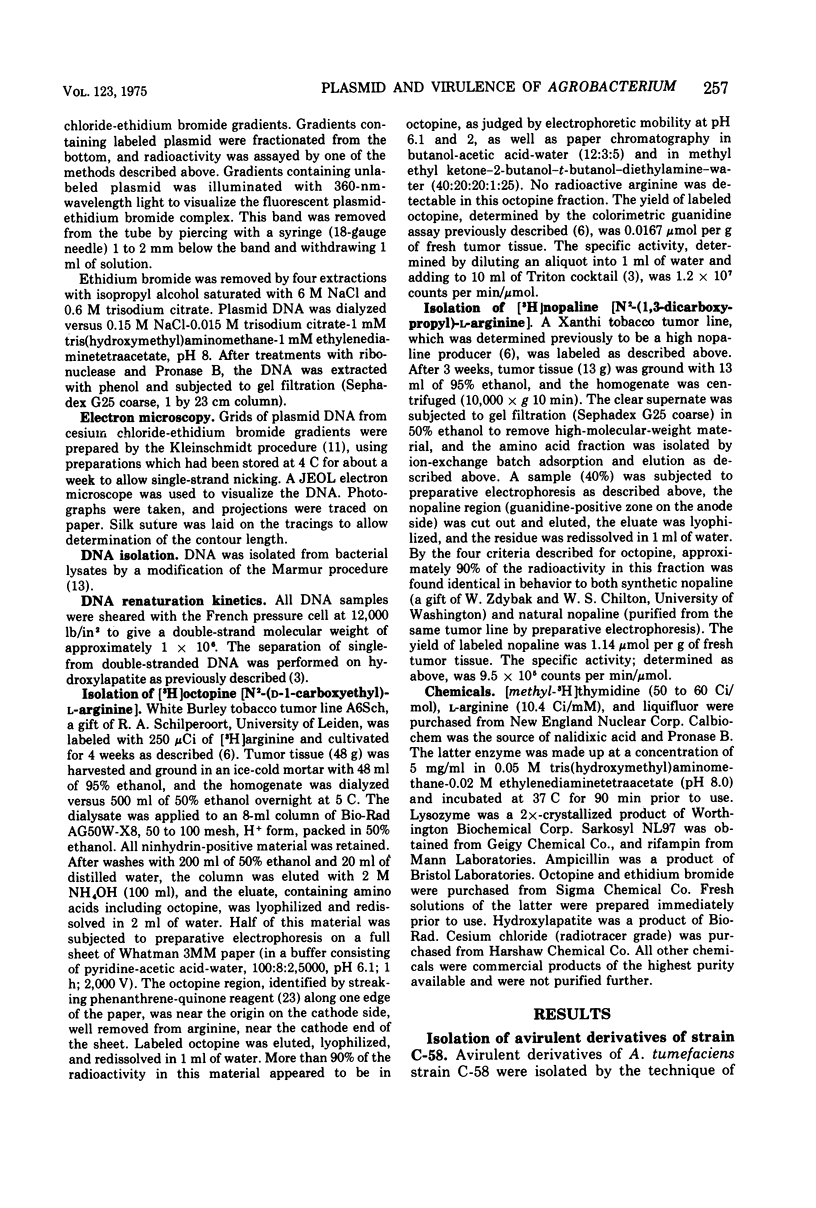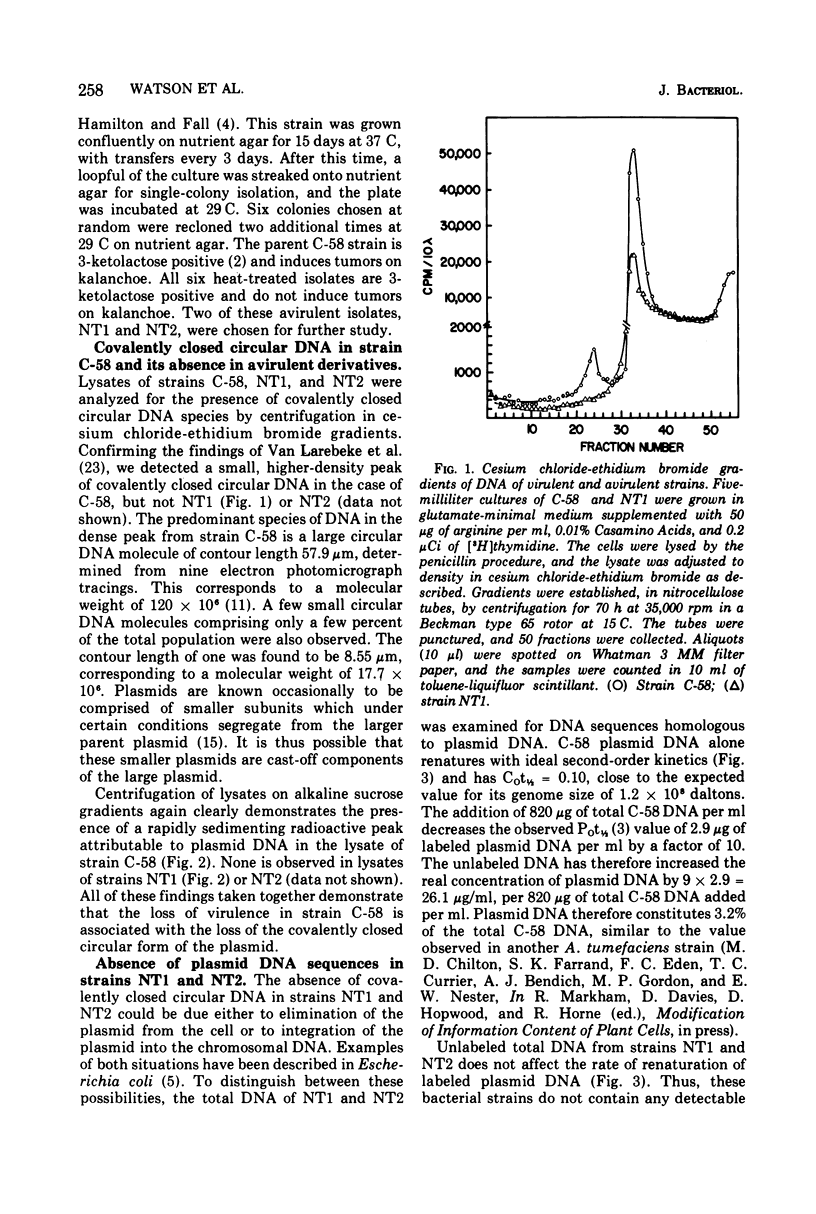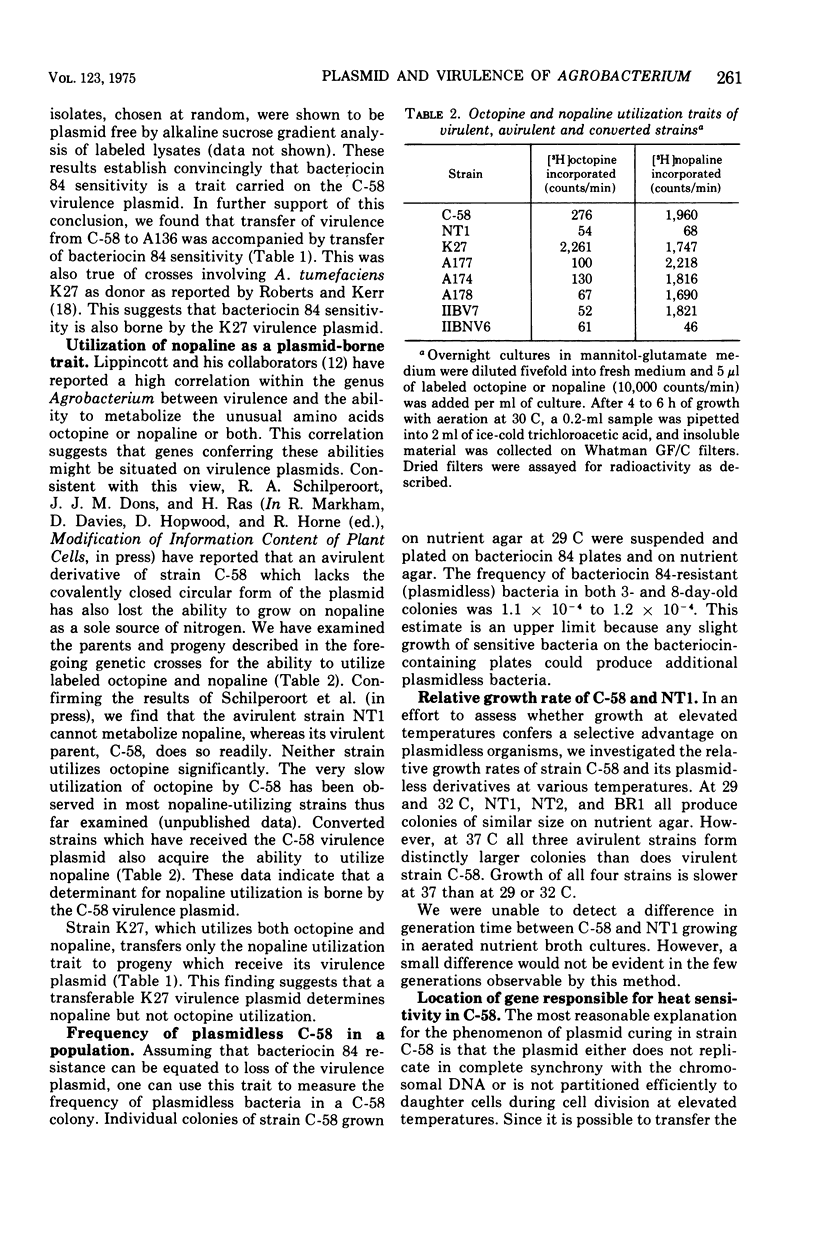Abstract
The irreversible loss of crown gall-inducing ability of Agrobacterium tumefaciens strain C-58 during growth at 37 C is shown to be due to loss of a large plasmid (1.2 X 10-8 daltons). The gene responsible for this high rate of plasmid loss at elevated temperatures seems to be located on the plasmid. In addition, another spontaneous avirulent variant, A. tumefaciens strain IIBNV6 is shown to lack the virulence plasmid which its virulent sibling strain, IIBV7, possesses. Deoxyribonucleic acid reassociation measurements prove that the plasmid is eliminated, not integrated into the chromosome, in both of the avirulent derivatives. Transfer of virulence from donor strain C-58 to avirulent recipient strain A136 results from the transfer of a plasmid, which appears identical to the donor plasmid by deoxyribonucleic acid reassociation measurements. The transfer of virulence in another cross, K27 X A136, was also shown to result from the transfer of a large plasmid. These findings establish unequivocally that the large plasmid determines virulence. Two additional genetic determinants have been located on the virulence plasmid of A. tumefaciens strain C-58: the ability to utilize nopaline and sensitivity to a bacteriocin produced by strain 84. The latter trait can be exploited for selection of avirulent plasmid-free derivatives of strain C-58. The trait of nopaline utilization appears to be on the virulence plasmid also in strains IIBV7 and K27.
Full text
PDF









Selected References
These references are in PubMed. This may not be the complete list of references from this article.
- Asheshov E. H. Loss of antibiotic resistance in Staphylococcus aureus resulting from growth at high temperature. J Gen Microbiol. 1966 Mar;42(3):403–410. doi: 10.1099/00221287-42-3-403. [DOI] [PubMed] [Google Scholar]
- Chilton M. D., Currier T. C., Farrand S. K., Bendich A. J., Gordon M. P., Nester E. W. Agrobacterium tumefaciens DNA and PS8 bacteriophage DNA not detected in crown gall tumors. Proc Natl Acad Sci U S A. 1974 Sep;71(9):3672–3676. doi: 10.1073/pnas.71.9.3672. [DOI] [PMC free article] [PubMed] [Google Scholar]
- Hamilton R. H., Fall M. Z. The loss of tumor-initiating ability in Agrobacterium tumefaciens by incubation at high temperature. Experientia. 1971 Feb 15;27(2):229–230. doi: 10.1007/BF02145913. [DOI] [PubMed] [Google Scholar]
- Johnson R., Guderian R. H., Eden F., Chilton M. D., Gordon M. P., Nester E. W. Detection and quantitation of octopine in normal plant tissue and in crown gall tumors. Proc Natl Acad Sci U S A. 1974 Feb;71(2):536–539. doi: 10.1073/pnas.71.2.536. [DOI] [PMC free article] [PubMed] [Google Scholar]
- KLEINSCHMIDT A. K., LANG D., JACHERTS D., ZAHN R. K. [Preparation and length measurements of the total desoxyribonucleic acid content of T2 bacteriophages]. Biochim Biophys Acta. 1962 Dec 31;61:857–864. [PubMed] [Google Scholar]
- Lippincott J. A., Beiderbeck R., Lippincott B. B. Utilization of octopine and nopaline by Agrobacterium. J Bacteriol. 1973 Oct;116(1):378–383. doi: 10.1128/jb.116.1.378-383.1973. [DOI] [PMC free article] [PubMed] [Google Scholar]
- MAY J. W., HOUGHTON R. H., PERRET C. J. THE EFFECT OF GROWTH AT ELEVATED TEMPERATURES ON SOME HERITABLE PROPERTIES OF STAPHYLOCOCCUS AUREUS. J Gen Microbiol. 1964 Nov;37:157–169. doi: 10.1099/00221287-37-2-157. [DOI] [PubMed] [Google Scholar]
- Nisioka T., Mitani M., Clowes R. Composite circular forms of R factor deoxyribonucleic acid molecules. J Bacteriol. 1969 Jan;97(1):376–385. doi: 10.1128/jb.97.1.376-385.1969. [DOI] [PMC free article] [PubMed] [Google Scholar]
- STONIER T. Agrobacterium tumefaciens Conn. II. Production of an antibiotic substance. J Bacteriol. 1960 Jun;79:889–898. doi: 10.1128/jb.79.6.889-898.1960. [DOI] [PMC free article] [PubMed] [Google Scholar]
- STONIER T. Labeling crown gall bacteria with P32 for radioautography. J Bacteriol. 1956 Aug;72(2):259–268. doi: 10.1128/jb.72.2.259-268.1956. [DOI] [PMC free article] [PubMed] [Google Scholar]
- Terawaki Y., Takayasu H., Akiba T. Thermosensitive replication of a kanamycin resistance factor. J Bacteriol. 1967 Sep;94(3):687–690. doi: 10.1128/jb.94.3.687-690.1967. [DOI] [PMC free article] [PubMed] [Google Scholar]
- Van Larebeke N., Engler G., Holsters M., Van den Elsacker S., Zaenen I., Schilperoort R. A., Schell J. Large plasmid in Agrobacterium tumefaciens essential for crown gall-inducing ability. Nature. 1974 Nov 8;252(5479):169–170. doi: 10.1038/252169a0. [DOI] [PubMed] [Google Scholar]
- Yamada S., Itano H. Phenanthrenequinone as an analytical reagent for arginine and other monosubstituted guanidines. Biochim Biophys Acta. 1966 Dec 28;130(2):538–540. doi: 10.1016/0304-4165(66)90256-x. [DOI] [PubMed] [Google Scholar]
- Zaenen I., Van Larebeke N., Van Montagu M., Schell J. Supercoiled circular DNA in crown-gall inducing Agrobacterium strains. J Mol Biol. 1974 Jun 15;86(1):109–127. doi: 10.1016/s0022-2836(74)80011-2. [DOI] [PubMed] [Google Scholar]


